

The Gambino Crime Family — The Castellammarese War. Lucky Luciano On April 15, 1931, gangster Charles "Lucky" Luciano invited his boss Giuseppe "Joe the Boss" Masseria to lunch at Nuova Villa Tammaro in Coney Island, Brooklyn.
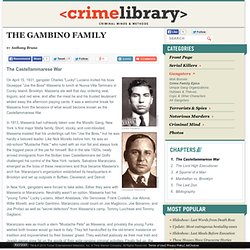
Masseria ate well that day, ordering veal, linguini, and red wine, and after the meal he and his trusted lieutenant whiled away the afternoon playing cards. Recherche. Epic saga of the Genovese Crime Family — Lucky. S Genovese crime family, the largest and most influential crime family in the , may have been born with the swipe of a knife over a clean-shaven cheek that left a lasting scar and an incentive for the man who received it, Charles, Lucky Luciano.
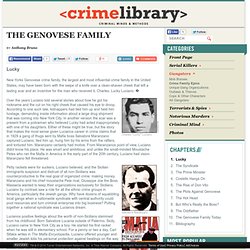
Charles "Lucky" Luciano Over the years Luciano told several stories about how he got his nickname and the cut on his right cheek that caused his eye to droop. According to one such tale, kidnappers had tied him up and held him hostage, demanding inside information about a large drug shipment that was coming into . In another version the scar was a present from a policeman who believed Lucky had acted inappropriately with one of his daughters.
Either of these might be true, but the story that makes the most sense given Lucianos career in crime claims that in 1929 a gang of thugs sent by Mafia boss Salvatore Maranzano captured Luciano, tied him up, hung him by his arms from the rafters, and tortured him. Salvatore Maranzano. Colombo Crime Family — The Rally. Columbus Circle from the air On , tens of thousands of people converged on s for the second annual Italian-American Civil Rights League rally.

Police barricades rerouted traffic away from the event. On an outdoor stage festooned with red, white, and blue fringed streamers, prominent politicians and local celebrities gathered to lend their support. Red, white, and green flags of were unfurled beside the Stars and Stripes. Television cameramen and newspaper photographers shouldered their way through the crowd to get as close to the podium as possible. Italian flag. Seattle Colacurcio Search. Five Families. Charles "Lucky" Luciano is considered the father of modern organized crime and is responsible for splitting New York into five different families The Five Families are the five original Italian American Mafia crime families of New York City which have dominated organized crime in the United States since 1931.
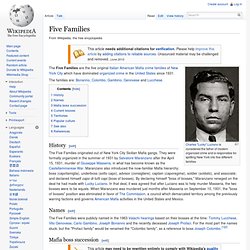
The families are: Bonanno, Colombo, Gambino, Genovese and Lucchese. History[edit] Colombo crime family. The Colombo crime family is the youngest of the "Five Families" that dominates organized crime activities in New York City, United States, within the nationwide criminal organization known as the Mafia (or Cosa Nostra).

The family traces its roots to a bootlegging gang formed by Joseph Profaci in 1928. After the reorganization of the American Mafia in the Castellammarese War, Profaci's gang was recognized as the Profaci crime family. Profaci would rule his family without interruption or challenge until the late 1950s.[2][3] The family has been torn by three internal wars. The first war took place during the late 1950s when capo Joe Gallo revolted against Profaci.
Lucchese crime family. The Lucchese crime family (pronounced [lukˈkeːse]) is one of the "Five Families" that dominates organized crime activities in New York City, United States, within the nationwide criminal phenomenon known as the Mafia (or Cosa Nostra).
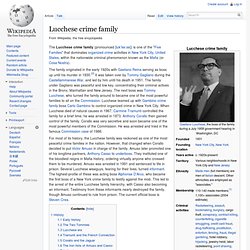
For most of its history, the Lucchese family was reckoned as one of the most peaceful crime families in the nation. However, that changed when Corallo decided to put Victor Amuso in charge of the family. Amuso later promoted one of his longtime partners, Anthony Casso to underboss. They instituted one of the bloodiest reigns in Mafia history, ordering virtually anyone who crossed them to be murdered. Amuso was arrested in 1991 and sentenced to life in prison. History[edit] Early history[edit] Gambino crime family. The rise of what for a time was the most powerful crime family in America began in 1957, the day Albert Anastasia was assassinated while sitting in a barber chair at the Park-Sheraton Hotel in Manhattan.
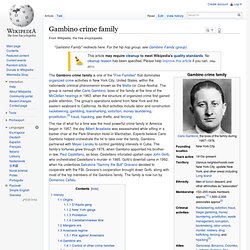
Experts believe Carlo Gambino helped orchestrate the hit to take over the family. Gambino partnered with Meyer Lansky to control gambling interests in Cuba. The family's fortunes grew through 1976, when Gambino appointed his brother-in-law, Paul Castellano, as boss. Castellano infuriated upstart capo John Gotti, who orchestrated Castellano's murder in 1985. Genovese crime family. Finding new ways to make money in the 21st century, the Genovese family took advantage of lax due diligence by banks during the housing spike with a wave of mortgage frauds.
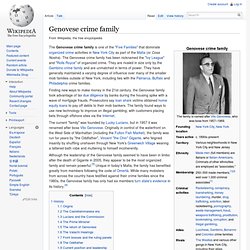
Prosecutors say loan shark victims obtained home equity loans to pay off debts to their mob bankers. The family found ways to use new technology to improve on illegal gambling, with customers placing bets through offshore sites via the Internet. Five Families. Charles "Lucky" Luciano is considered the father of modern organized crime and is responsible for splitting New York into five different families The Five Families are the five original Italian American Mafia crime families of New York City which have dominated organized crime in the United States since 1931.
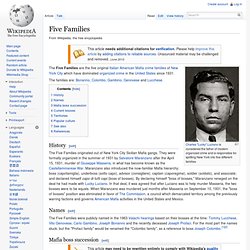
The families are: Bonanno, Colombo, Gambino, Genovese and Lucchese. History[edit] Corleonesi. Not to be confused with the fictional Corleone family.

The Corleonesi Mafia clan are a Mafia clan and a part of Cosa Nostra in the 1980s and the 1990s. The informal name Corleonesi was applied by the media and government because its most important leaders came from the town of Corleone, first Luciano Leggio and later Totò Riina, Bernardo Provenzano and Leoluca Bagarella, Riina’s brother-in-law. The Corleonesi coalition managed to take over the Sicilian Mafia Commission and imposed a quasi-dictatorship over Cosa Nostra, waging war against rival factions (also known as the Second Mafia War) from 1978-1983. The more established Mafia factions in the city of Palermo grossly underestimated the mafiosi from Corleone and often referred to the Corleonesi as i viddani – "the peasants".
Affiliations and membership beyond Corleone[edit] Corleonesi affiliates were not restricted to mafiosi of Corleone. "He liked to kill. "They took power by slowly, slowly killing everyone . . References[edit] Bernardo Provenzano. Bernardo Provenzano (Italian pronunciation: [berˈnardo provenˈtsaːno]; born January 31, 1933 in Corleone, Sicily) is a member of the Sicilian Mafia (Cosa Nostra) and is suspected of having been the head of the Corleonesi, a Mafia faction that originated in the town of Corleone, and de facto capo di tutti capi (boss of bosses) of the entire Sicilian Mafia until his arrest in 2006. His nickname is Binnu u tratturi (Sicilian for "Binnie the tractor") because, in the words of one informant, "he mows people down. "[1] Another nickname is The Accountant due to his apparently subtle and low-key approach to running his crime empire, at least in contrast to some of his more violent predecessors.[1][2] Early years[edit] He was born and raised in Corleone, the third of seven brothers, born to peasants.
The Family Business. The World's Most Secretive Businessmen. The mafia. The mob. La Cosa Nostra. Whatever you call it, America's national crime syndicate is powerful, entrenched and almost impossible to nullify. Federal and local law enforcement have tried to stamp out organized crime for almost as many years as it has existed. The sheer size and scope of organized crime makes that nearly impossible. Organized crime activities bring in a worldwide annual income of between $50 billion and $90 billion according to a 2002 FBI study — more money than any major legitimate national industry. And it's all lead by the bosses. Colacurcio Jr. and an associate plead guilty to "Strippergate" charges. Originally published January 24, 2008 at 12:00 AM | Page modified January 24, 2008 at 4:46 PM With a touch of defiance, Seattle strip-club owner Frank Colacurcio Jr. and a longtime associate pleaded guilty today to criminal charges related to the so-called "Strippergate" campaign-finance scandal of 2003.
His father, Frank Colacurcio Sr., was also expected to plead guilty to the same charges, but the longtime strip-club magnate, who is 90, did not appear in court due to health problems. His attorney said Colacurcio Sr. will enter a plea by Monday. In a plea bargain that avoided jail time, Colacurcio Jr. agreed to pay a $10,000 fine and one year of probation.
His father is expected to accept an identical deal. Those penalties are in addition to a $55,000 civil settlement approved Wednesday by the Seattle Ethics and Elections Commission. Colacurcio Jr. refused to comment after the court proceeding. Rick Porrello's - AmericanMafia.com - The Organized Crime and Mafia Super Site. Bonanno crime family. The Bonanno crime family is one of the "Five Families" that dominates organized crime activities in New York City, United States, within the nationwide criminal phenomenon known as the American Mafia (or Cosa Nostra). History[edit] Sicilian origins[edit] Castellammarese War[edit] In 1927, violence broke out between the two rival New York Mafia factions and soon developed into a full out war known as the Castellammarese War.[5] The conflict started when members of the Castellammarese clan began hijacking truckloads of illegal liquor that belonged to Giuseppe "Joe the Boss" Masseria.
The Castellammarese clan was based in Williamsburg, Brooklyn and led by Nicola "Cola" Schirò who tried to work with Masseria. The Castellammarese faction was more organized and unified than Masseria family. After Reina's murder on February 26, 1930, members of the Masseria faction began to defect to Maranzano.[5] By 1931, momentum had shifted to Castellammarese faction. Salvatore Riina. Salvatore "Totò" Riina (born 16 November 1930) is a member of the Sicilian Mafia who became the most powerful member of the criminal organization in the early 1980s. Fellow mobsters nicknamed him The Beast (La Belva) due to his violent nature, or sometimes The Short One (U curtu) due to his diminutive stature.
During his lifelong career in crime he is believed to have personally killed around forty people and to have ordered the deaths of several hundreds more. [citation needed] Michele Navarra. Michele Navarra (January 5, 1905 – August 2, 1958) was a powerful member of the Sicilian Mafia.